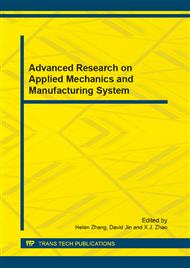[1]
CABR. Concrete structure design [M]. Beijing:China Architecture and Building Press, (2003).
Google Scholar
[2]
GB50010-2002 CSBN [S]. Beijing:China Architecture and Building Press, (2002).
Google Scholar
[3]
Hao Qing-duo, Wang Yan Lei, Ou Jin-ping. Research on protection thickness of concrete beams with GFRP/ steel wire composite rebar [J]. Journal of Building Structures, 2008, 29(1): 67-73.
Google Scholar
[4]
Li Zhenzhen. Research on the mechanical behavior of the normal section of concrete beams with FRP rebar [D]. Zhengzhou:Zhengzhou University, (2005).
Google Scholar
[5]
Zheng Qiao-wen. Research on design theory of concrete beams with FRP rebar. [D]. Shang Hai:Tongji University, (2006).
Google Scholar
[6]
ACI 440 Committee. Guide for the design and construction of concrete reinforced with FRP bars[R]. USA: American Concrete Institute, (2006).
Google Scholar
[7]
Hao Qing-duo. The mechanical behavior and design methods of concrete beams with GFRP/ steel wire composite rebar [D]. Harbin:Harbin institute of technology, (2009).
Google Scholar
[8]
CSA S806-02. Design and Construction of Building Components with Fiber Reinforced Polymers[R]. Canada: Canadian Standards Association, (2002).
Google Scholar
[9]
NEMHOOK J, GHALI A and TADROS G. Cracking and deformability of concrete flexural sections with fiber reinforced polymer[J]. Journal of Structural Engineering. 2002, 128(9): 1195-1201.
DOI: 10.1061/(asce)0733-9445(2002)128:9(1195)
Google Scholar
[10]
VIJAY P V. Aging and Design of Concrete Members Reinforced with GFRP Bars[D]. New York: West Virginia University, 1999, 105-118.
Google Scholar
[11]
VIJAY P V, GANGARAO H V S. Bending behavior and deformability of glass fiber-reinforced polymer reinforced concrete members[J]. ACI Structural Journal. 2001, 98(6): 834-842.
DOI: 10.14359/10750
Google Scholar
[12]
Zhang Peng. The test study and theory analysis on the mechanical behavior of concrete beams with FRP rebar. [D]. NanNing:GuangXi University, 2006, 15-26.
Google Scholar
[13]
ACI 318-02. Building Code Requirements for Structural Concrete[R]. USA: American Concrete Institute. (2002).
Google Scholar
[14]
NEMHOOK J, GHALI A and TADROS G. Concrete flexural members reinforced with fiber reinforced polymer: design for cracking and deformability[J]. Canadian Journal of Civil Engineering, 2002, 29: 125-134.
DOI: 10.1139/l01-085
Google Scholar
[15]
ABDELRAHMAN A A, RIZKLLA S H. Deflection control of concrete beams pretensioned by CFRP reinforcements. Journal of Composites for Construction[J], 1999, 3(2): 55-62.
DOI: 10.1061/(asce)1090-0268(1999)3:2(55)
Google Scholar


